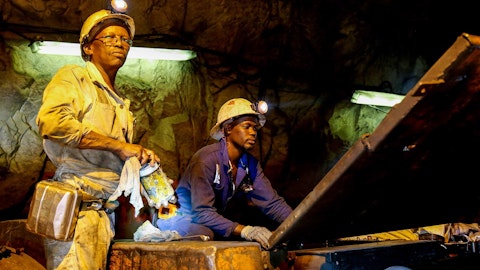In addition to that, we’ve started the fourth isothermal press, and we have added SONiC testing. And that SONiC testing was a bottleneck in the business. So as you look forward to Q2 and the second half of the year, for HPMC, you’re seeing a lift in volumes. You’re seeing — and that’s debottlenecking as well as production efficiency. Don’t forget the new assets that are coming online. We talked about the Albany Oregon facility that we restarted in 2023. That would be ramping up and really hitting income statement run rates in the second half of the year. That’s a good guy. And then just the general overall — the efficiencies that we’re going after in HPMC. The — and then just one more thing if you bear with me. As you think about the volume increase, where is it happening?
Well, it’s happening in Aerospace and Defense and Aero Like, those are our richest margin product offerings. And so that’s going to be beneficial to margins. So volume increases, greater efficiencies, great mix impacts and investor flow. That’s — those are — those all set the stage for answering your question what the heck’s going to happen with HPMC margins. The good news is they’re going up. We expect by — certainly in Q2, we’re going to see HPMC margin back above the 20% level. And as the year progresses, we would expect that those margins in the Q3 and Q4 kind of time frame would be in the 23% range, which is right in line with the targets that we have for 2025, which as you know are low 20s to mid-20s for HPMC. Now if we’re going to talk about margins, I want to also just give you a sense as to how we’re thinking about margins in the broader business.
And so if you think about ATI consolidated, so our experience this last quarter was 14.5% EBITDA margin. And I would expect that with each passing quarter, our consolidated EBITDA margins would be increasing. And for the overall business, our 2025 targets are EBITDA margins in the 18% to 20% range. Where we exit 2024 is an important point in terms of our ability to close the gap and hit that 18% to 20% margin target. So how should we think about our expected margin exit rate for Q4 of this year? I would expect the consolidated EBITDA margins to be in the range of 16.5% to 17%. And then of course, we’re targeting 17% in our business. So that — delivering 17% as the Q4 exit EBITDA margins really sets us up well to hit our 2025 range of 18% to 20%.
So hopefully, that’s helpful.
Seth Seifman: Yes, that was great. Such a robust answer. I will leave it at one for this morning. Thanks very much for your time.
Operator: Thank you. Our next question today comes from Timna Tanners of Wolfe Research. Your line is open.
Timna Tanners: Yes, hi. Good morning. Can you hear me, okay?
Robert Wetherbee: Yes, we get you loud and clear, Timna.
Timna Tanners: Okay. Great. Bob, congrats on a great run, and it seems like it’s been like — and just yesterday that you just started and did some — it’s great to see all your progress. I wanted to just ask about CapEx and capital allocation. So on CapEx, I know you’ve done a really good job of debottlenecking and having bite-sized kind of growth. But I just want to know, is that — how much more runway do you have of debottlenecking? How much more can you continue to kind of do these bite-sized increases in growth that way? What inning are we in there? And then second question, just a little bit more on the buybacks. Is this a good cadence to expect going forward? Is there an opportunistic element to your buyback where you look at the share price? Or do you just look at a steady amount over time? Thanks again.
Don Newman: Sure. Let me take that. In terms of CapEx and debottlenecking, first, I want to reinforce, the growth that we’re seeing in the business and the really strong trajectory that we’re sharing a part of today, is all built on the CapEx guidance that we’ve shared with the market up to this point. Our plan is, we expect to average $200 million of CapEx each year between now and through 2027, plus or minus. So in terms of debottlenecking and what are the opportunities, I would say we’re nowhere near really fully exhausting the opportunities and improving the production efficiencies and flows in our business. And I think that it’s fair to say that those opportunities exist throughout the business. And it starts with melt.
And so unlocking the melt capacity, like we have been working on, and we saw significant steps forward in Q1, that is the first step in really unlocking the bottlenecks in this business. So it’s very, very exciting. I talk about its effectively free capacity. And whatever debottlenecking investments that we’re making and support of increasing this flow is subsumed in our CapEx guidance that I just mentioned. So it’s not incremental to it. And then could you repeat your question around share buybacks?
Timna Tanners: Sure, yes. I was more about what’s the cadence that we might want to expect? Or does your board think about it in terms of a steady state or opportunistic?
Don Newman: I would say a combination. What we try to do with our Board is really look at things on an annual basis based upon our planned liquidity and cash generation. We make a recommendation to the Board in terms of a level of CapEx, de-levering and share buybacks. That balanced deployment strategy I’ve talked about. And so it’s typical to talk to the Board about that earlier in the year. And that’s what we did this year. Actually, we accelerated a little bit and did it at the end of last year. And that worked out extremely well. We have repurchased shares early enough in Q1 before the run-up in our stock that probably saved us $15 million to $20 million because of that being proactive on that, Timna. In terms of being opportunistic, the short answer there is, yes, we would expect to be opportunistic and to have a cadence.
Opportunistic, this is a great example. So we expanded the 2024 program of $150 million that was originally planned to be executed late in the year, while we pulled that forward for a number of reasons, a number of really good reasons. Now we’re seeing this very healthy cash generation profile for the rest of the year. We would go back to our board and have conversations around them — around the topic with them, should we allocate more capital for additional share repurchases this year. But it is important to remember as we think about capital deployment and cash generation, the idea of having a balanced deployment strategy is not a one-off, one-year or two-year kind of strategy. So investing for growth, investing for de-levers and returning capital to our shareholders is something that is a continuation in our business.




